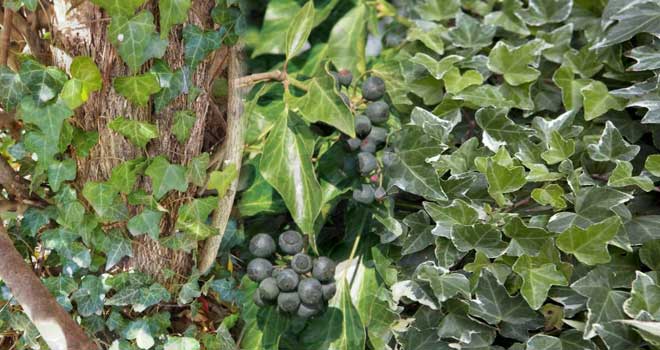Natural Remedies - Healing with Medicinal Herbs

Ivy (Hedera helix Araliaceae)
Other Names: Common Ivy, English Ivy
Ivy, an evergreen climber native to Europe and Asia, grows by crawling or climbing walls, hedges, and trees using tiny aerial roots resembling hooks. It has two leaf forms: entire-edged leaves on flowering branches and deeply incised, three- to five-lobed leaves on non-flowering branches. Its tiny greenish-yellow flowers produce spherical, usually black fruits.
Parts for Use
Wood and Leaves
- Wood from mature branches is peeled and cut into small pieces for infusions or syrups.
- Young, fresh leaves are collected for use in ointments and creams.
Ingredients
Ivy wood contains saponins that relieve cramps and aid expectoration. Leaves also contain saponins, sterols, phenols, flavonoids, mucus (soothes coughs), tannins, anthocyanins, and the alkaloid emetine.
Use in Treatment
Internally, ivy wood is used for coughs and bronchitis due to its antispasmodic, expectorant, and sore throat-relieving properties. A 1997 study confirmed its ability to soothe cramps and the efficacy of leaf extract in aiding mucus expulsion and combating fungal infections and tumors. Externally, ivy wood and leaf extracts are used in cosmetic preparations for cellulite (alongside weight loss methods) and in creams for itchy skin, burns, warts, itching, and rheumatism.
Cultivation
Ivy tolerates most soil types and thrives in full shade. Propagate using semi-woody cuttings in summer.
Preparation and Dosage
For Internal Use (Cough and Bronchial Disorders)
- Infusion: Place one bag in 200 ml of boiling water, let stand for 5 minutes, and take 1–2 cups daily during meals.
- Syrup (from extract): Take 1–3 tablespoons daily.
For External Use (Itchy Skin and Cellulite)
- Cream or Gelatin: Apply to the affected area 2–3 times daily.
Warnings
- Consult a healthcare professional before use.
- Excessive use may cause diarrhea, stomach irritation, vomiting, or a slowed heart rate.
- Ivy berries are poisonous and should not be consumed.
- While leaves have not shown toxicity, handling during harvest or preparation may cause dermatitis.





